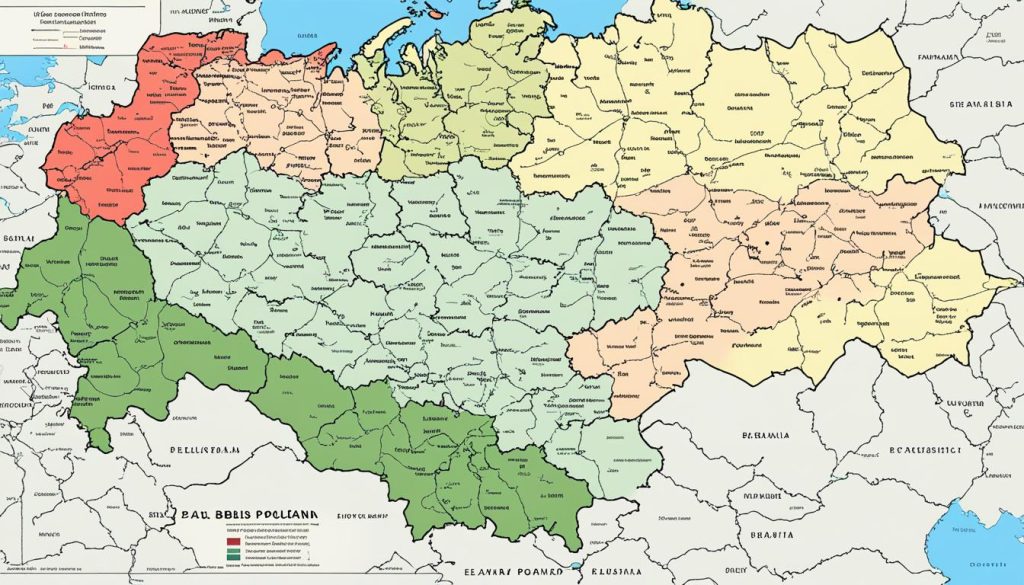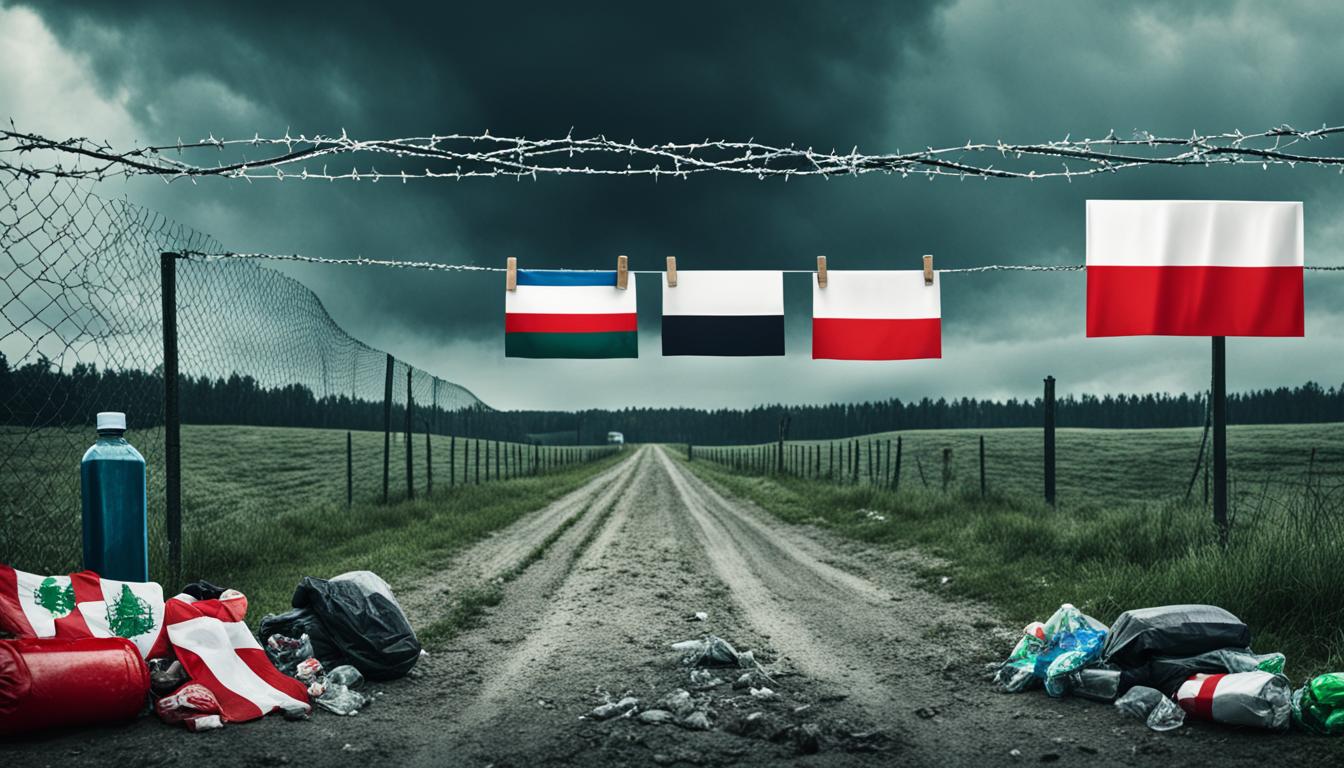The Belarus-Poland border tension is a major problem in Eastern Europe today. It’s complicated and has many layers. This crisis challenges both countries and the wider world. Understanding what’s happening on this border is crucial. It involves migration, politics, and safety issues that worry many people. We’ll look closely at what’s causing this trouble and explain the complex issues at Eastern Europe’s border.
Key Takeaways
- The Belarus-Poland border conflict underscores significant geopolitical strife within Eastern Europe.
- Migratory regulations and the resultant standoffs have intensified scrutiny from the global stage.
- Examining the roots and repercussions of these border tensions is imperative for understanding regional security concerns.
- Key figures in government and international bodies remain at the forefront in navigating this multifaceted crisis.
- The situation demands a nuanced appreciation of historical grievances and contemporary geopolitical strategies.
The Evolution of Belarus-Poland Border Disputes
The Belarus-Poland border disputes are deeply rooted in history. They stem from past events, growing strains, and global rules. To grasp the current conflict, we need to look at its history, examine recent tensions, and consider international laws and broken agreements.
Historical Context of the Conflict
The border dispute history between Belarus and Poland goes back to after World War II. This period reshaped Eastern Europe’s political landscape. The borders set then caused ongoing issues, stoking national pride and leading to repeated clashes.

Recent Escalations and Their Triggers
Recent border tensions have been sparked by specific incidents. Belarus directing migrants towards Poland led to a strong military reply from the Polish side. This situation points to how quickly old disputes can come back to life.
The Role of International Agreements and Breaches
International law plays a key role in resolving these disputes by providing guidelines. However, border agreement violations have at times made peaceful solutions difficult. These breaches test international bodies’ ability to enforce standards and maintain peace.
| Year | Incident | Belarus Response | Poland Response | International Law Implication |
|---|---|---|---|---|
| 2020 | Migrant Instrumentalisation | Facilitation of migrant crossings | Increased border security | Debate on refugee rights and border sovereignty |
| 2021 | Military Build-Up | Defence posturing | Deployment of troops | Questions on military aggression and use of force |
| 2022 | Diplomatic Tensions | Political rhetoric escalation | Appeal to international bodies | Examination of diplomatic conduct under international law |
The Belarus-Poland border issue is an ongoing story of past conflicts, present challenges, and legal matters. It highlights the struggle for lasting peace, respect for national sovereignty, and human rights. The outcomes are shaped by international law, previous agreements, and their violations.
Political Implications for Belarus and Poland
The politics of Belarus and Poland’s reaction to border tensions show a complex picture. This situation fuels national discussions, shapes the area’s geopolitical tactics, and might change power balances and alliances in the region.
Both countries face big challenges. Belarus tries to keep its independence while facing global pressure. Poland, meanwhile, has to protect its borders while dealing with the human side of these actions.
The effects of these tensions spread far, making nearby countries think about their alliances. An analysis shows how different and alike the strategies of these countries are. It sheds light on the ongoing situation.
| Aspect | Belarus | Poland |
|---|---|---|
| Internal Political Discourse | Heightened nationalism and defensive policies | Increased security measures and public debate on migration |
| International Strategy | Seeking allies amidst growing isolation | Balancing between robust defence and EU obligations |
| Domestic Political Repercussions | Consolidation of power aganist Western criticism | Political divisions over approach to crisis |
| Influence on Bilateral Relations | Worsening ties with immediate neighbours | Strengthening of regional security partnerships |
| Potential for Geopolitical Shifts | Exploration of new diplomatic alliances outside the West | Enhanced cooperation with NATO and EU nations |
This table shows the complex nature of
geopolitical strategy
. Every decision and move by these countries affects the region’s landscape. As things develop, Poland keeps adapting its stance. This happens under the global community’s eyes, while Belarus balances internal strength with outside dealings.
The Impact of the Belarus-Poland Border Crisis on EU Relations
The border crisis between Belarus and Poland is growing. It has caused the EU to respond in many ways. This situation tests EU-Belarus relations and brings up important questions. It makes us think about how the EU uses sanctions and helps those in need.
EU’s Response to the Growing Tensions
The EU had to step up because of the worsening situation at the Belarus-Poland border. They are trying to calm things down by talking and taking specific actions.
Sanctions and Diplomatic Efforts
The EU has put sanctions on some people and groups from Belarus. They did this to protect democracy and human rights. At the same time, they are also trying to find a peaceful solution to the border issue. They want to keep unity and integrity among EU countries.
Migrant Crisis and Humanitarian Concerns
The situation has led to a big refugee crisis. This puts attention on the need to help those suffering. The EU is giving aid, following international rules on human rights. They are committed to helping, while dealing with the politics of the crisis.
The EU is working carefully to solve this difficult problem. What they decide will greatly influence their relationships with Eastern Europe. It will also affect their reputation as leaders in democracy and human rights.
Conclusion
The analysis we’ve done shows how complex the situation is at the Belarus-Poland border. It looks into historical issues, current geopolitical tactics, and the pressing humanitarian concerns. This all highlights the urgent need for effective solutions. Sustainable stability at the border requires countries working together.
In Eastern Europe, the need for talks and teamwork is growing. The European Union could lead in making peace and starting security, migration, and diplomatic talks. Success depends on sticking to international laws and respecting everyone’s rights. With the right diplomatic efforts, we could see Belarus and Poland move towards a friendlier relationship.
Looking ahead, solving this will need smart negotiations, sticking to agreements, and handling the refugee crisis with care. Creating a space for open and fair talks could change the area from a conflict zone to one of teamwork. Despite the current difficulties, there’s hope for peace through global unity and determination.
FAQ
What are the root causes of the Belarus-Poland border conflict?
This issue has deep roots, starting from after World War II. It’s grown due to different viewpoints in Eastern Europe. Modern problems like migration and security have made it worse.
How have recent events escalated tensions along the Belarus-Poland border?
Tensions grew when Belarus used migrants to provoke Poland. This led Poland to send its military to the border. Such acts broke international rules, making the situation tenser.
What role do international laws play in the Belarus-Poland border disputes?
International laws set the rules for solving border disputes. When these laws are ignored, it leads to global criticism. It shows how important it is to follow these rules.
What are the political implications of the border crisis for Belarus and Poland?
The crisis is changing both countries’ politics. It shapes how they’re seen globally and affects their domestic policies.
It’s also changing their relationships with others, which could shift the balance in the region.
How has the European Union responded to the growing tensions between Belarus and Poland?
The EU has put sanctions on Belarus and tried to calm things down with talks. They’re working on the migrant crisis and focusing on human rights at the same time.
What are the humanitarian concerns associated with the Belarus-Poland border crisis?
The situation has caused a severe migrant crisis. Key concerns are the treatment of these people, their rights to seek asylum, and getting them help under difficult conditions.
How might the Belarus-Poland border crisis affect future EU-Belarus relations?
This crisis will likely strain their relations more, possibly leading to more sanctions. It’s making the EU rethink its policy towards Eastern Europe.
A united EU approach is crucial for dealing with such conflicts.
What strategies could potentially resolve the Belarus-Poland border tensions?
Solving this needs diplomatic talks and sticking to international laws. Improving dialogue, working together internationally, and focusing on humanitarian needs are keys to finding peace.



